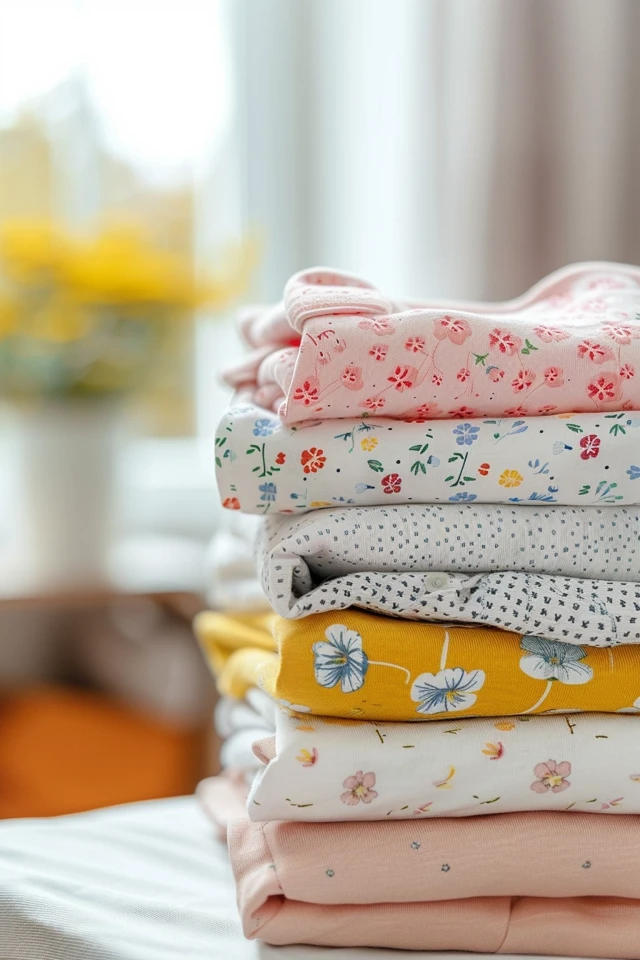When it comes to organizing and storing baby clothes, efficiency and space-saving solutions are key. As a parent, I know how quickly baby clothes can accumulate, and finding ways to maximize space while keeping everything neat and accessible is crucial.
By following these techniques for folding baby clothes, you can make the most out of limited storage space and ensure that your little one’s wardrobe is always tidy and easy to navigate.
Key Takeaways:
- Efficiently folding baby clothes can help maximize storage space.
- Proper organization and storage of baby clothes are essential for saving space.
- Consider using space-saving storage solutions specifically designed for baby clothes.
- Utilize folding techniques that minimize wrinkles and make it easier to find and access different items.
- Regularly declutter and donate or sell clothes that are no longer needed to free up space.
Now, let’s dive into some efficient folding techniques that will help you make the most out of every inch of storage space you have.

Efficient Folding Techniques for Baby Clothes
Folding baby clothes in the right way can make a big difference in how much space they take up. By utilizing these folding techniques, you can maximize space while keeping your baby’s clothes organized:
- Roll and tuck: Start by laying the baby clothes flat. Roll them tightly from one end to the other. Once rolled, tuck the ends into the center of the roll. This technique is ideal for onesies, rompers, and pajamas, allowing you to stack them vertically in drawers or storage containers.
- Accordion fold: Lay the baby clothes flat and fold each side towards the center, creating a rectangular shape. Then, fold the rectangle in half or thirds to maximize space. This method is great for t-shirts, pants, and skirts, allowing you to place them horizontally in drawers or storage bins.
- Envelope fold: Lay the baby clothes flat and fold one side towards the center. Then, fold the other side over the first fold, creating an envelope-like shape. This technique works well for small items such as socks, hats, and mittens, enabling you to stack them neatly in a designated drawer or clear storage pockets.
Efficient folding techniques not only save space but also make it easier to find items when you need them. Organizing baby clothes using these methods can alleviate the woes of rummaging through cluttered drawers.”
By implementing these folding techniques, you can create a more organized and visually appealing storage solution for your baby’s clothes. It’s time to say goodbye to jumbled piles and hello to a space-saving wardrobe!

Organizing and Storing Baby Clothes for Space Saving
When it comes to maximizing the space in your baby’s nursery, efficient folding techniques are just the beginning. Organizing and storing baby clothes properly can also make a significant difference. Here are some practical solutions to help you save space while keeping your little one’s clothes easily accessible:
1. Utilize storage bins or baskets: Invest in storage bins or baskets that can be stacked or tucked away in closets or under the crib. Sort baby clothes by size, season, or type and label each container to easily locate items when needed.
2. Hanging organizers: Use hanging organizers with individual compartments to store socks, hats, and other small accessories. Hang these organizers on the back of the nursery door or inside the closet to free up valuable shelf and drawer space.
3. Vacuum-sealed bags: If you have limited storage space, consider using vacuum-sealed bags to compress and store out-of-season or rarely used baby clothes. These bags reduce the volume of clothing significantly, allowing you to store more in less space.
4. Drawer dividers: Invest in drawer dividers to separate baby clothes neatly within the dresser. This will not only create a more organized appearance but also maximize drawer space by utilizing every inch effectively.
By implementing these baby clothes storage solutions and organizing techniques, you can create a functional and space-saving nursery that is both practical and aesthetically pleasing. With everything neatly organized and easily accessible, you’ll have more time to enjoy those precious moments with your little one.


